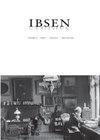The Form of Finitude: AASE’s Death in Peer Gynt
IF 0.1
0 THEATER
引用次数: 0
Abstract
Given how thoroughly Ibsen is identified with his prose dramas it is perhaps unsurprising that relatively little attention has been paid to his verse. When it is discussed at all, it tends to be in terms of the light it sheds on his later production or, at best, in the context of the closet dramas Brand and Peer Gynt. In studies of these latter works, however, purely poetic considerations are mostly sidelined by attention to questions of character or plot. If understandable, this tendency is nevertheless highly regrettable since Ibsen was an eminently accomplished poet whose craft amply rewards detailed examination. Perhaps this is nowhere as apparent as in the magnificent scene of Aase’s death in Peer Gynt (584–595), made famous, not least, by Edvard Grieg’s musical version. The passage is widely recognized as an extraordinary achievement and yet, to the best of my knowledge, it has not previously been subjected to detailed analysis. In what follows, I offer a close reading of some of this scene’s poetic features, both as a way to unpack its overall dynamic and to suggest a few of its broader aesthetic implications. In basic terms, my argument is that the scene divides in two. The first half consists of three distinct attempts to escape the fact of death by deploying the creative force of poetry and narrative in three different temporal有限性的形式:AASE在皮尔金特的死亡
鉴于易卜生对他的散文戏剧有着如此彻底的认同,人们对他的诗歌关注相对较少或许并不奇怪。当人们讨论这件事时,往往是从它对他后来的作品的启示来看,或者充其量是从壁橱里的戏剧《布兰德》和《皮尔·金特》的背景来看。然而,在对后一部作品的研究中,纯粹的诗歌考虑大多被对人物或情节问题的关注所忽视。如果可以理解的话,这种倾向是非常令人遗憾的,因为易卜生是一位杰出的诗人,他的技艺充分值得仔细研究。也许这一点在Peer Gynt(584–595)的Aase之死的壮丽场景中最为明显,该场景因爱德华·格里格的音乐版本而闻名。这篇文章被广泛认为是一项非凡的成就,但据我所知,它以前还没有经过详细的分析。在接下来的文章中,我细读了这一场景的一些诗意特征,既可以解读其整体动态,也可以暗示其更广泛的美学含义。从根本上讲,我的论点是场景一分为二。前半部分包括三次不同的尝试,通过在三个不同的时间中运用诗歌和叙事的创造力来逃避死亡的事实
本文章由计算机程序翻译,如有差异,请以英文原文为准。
求助全文
约1分钟内获得全文
求助全文

 求助内容:
求助内容: 应助结果提醒方式:
应助结果提醒方式:


